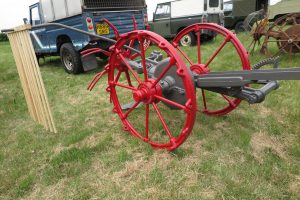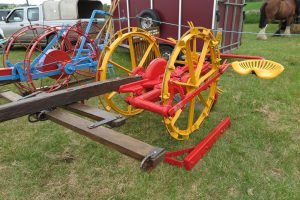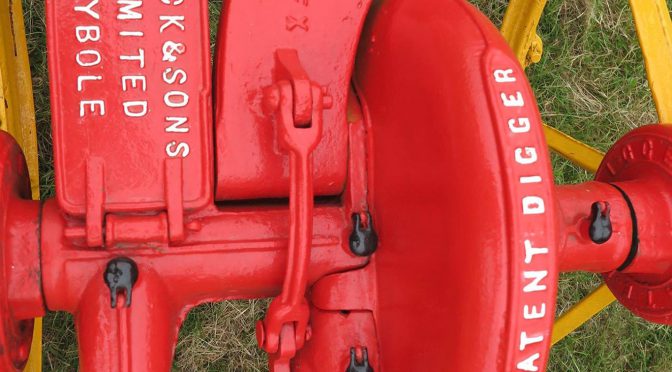The tattle spinner was patented By J. Hanson, in 1855. By 1875 there were a number of makers of spinner diggers in Scotland whose names continued to be associated with that machine until well into the twentieth century.
 They included J. D. Allan & Sons, Culthill, Dunkeld, J. Bisset & Sons, Blairgowrie, James Gordon, Castle Douglas, Andrew Pollock, Machine, Ayrshire (Later A. & W. Pollock), and John Wallace & Sons, Glasgow.
They included J. D. Allan & Sons, Culthill, Dunkeld, J. Bisset & Sons, Blairgowrie, James Gordon, Castle Douglas, Andrew Pollock, Machine, Ayrshire (Later A. & W. Pollock), and John Wallace & Sons, Glasgow.
If you were looking for a spinner digger in 1910 you would have been able to purchase one from all of these makers. In addition, you could have purchased one from Alexander Ballach & Sons, Leith, as well as George Sellar & Son, Huntly, Kemp & Nicholson, Stirling, A. Jack & Sons, Maybole, A. Newlands & Son, Linlithgow, and David Wilson, East Linton. They had outstanding reputations as makers of spinners within Scotland, as also across Britain, and for some throughout the world.
 A number of these makers entered machines into the Royal Highland and Agricultural Society of Scotland’s tattie digger trials in 1911. This was the first time that the Society had held a trial that focused on this implement for a good number of years: the earlier trail of 1881 had been a milestone.
A number of these makers entered machines into the Royal Highland and Agricultural Society of Scotland’s tattie digger trials in 1911. This was the first time that the Society had held a trial that focused on this implement for a good number of years: the earlier trail of 1881 had been a milestone.
Entries to the trial were to be on “entirely new principles, or possess radical improvements on machines now in use.” Each was also to have been exhibited at the Highland Show in inverness in 1911.
The trial, held at Turnhouse, Cramond, Midlothian, on 5 October 1911, was watched by a large number of spectators. The machines included some “novel” and “interesting” features. The machine from John Wallace & Sons had a rotating arm carrying the grapes or tines set at one side of the drill, and the tines were set so that they entered the drill laterally and lifted it up.
 The judges concluded that the work done by all the machines was “fairly good” and “showed improvement as compared with the results obtained at the last trial.” However, there was no outstanding machine. As a result, equal premiums were awarded to machines from J. D. Allan, A. & W. Pollock, John Wallace & Son and David Wilson.
The judges concluded that the work done by all the machines was “fairly good” and “showed improvement as compared with the results obtained at the last trial.” However, there was no outstanding machine. As a result, equal premiums were awarded to machines from J. D. Allan, A. & W. Pollock, John Wallace & Son and David Wilson.
What the trial achieved was to stimulate the development in tattle diggers and to try to find ways to make diggers more effective. It went down in the annals of the Society’s work to encourage technological innovation.
For further information see “Trial of potato diggers or lifters”, Transactions of the Highland and Agricultural Society of Scotland, 1911, pp. 383-398. http://archive.rhass.org.uk
The potato diggers were exhibited at the Fife Vintage Agricultural Society’s rally, June 2016.
© 2016 Heather Holmes
